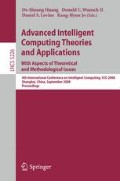Abstract
A number of cortex-like hierarchical models of object recognition have been proposed these years. In this paper, we improve them by introducing supervision during forming combined local features. The traditional cortex-like hierarchical models always contain three layers which imitate the functions of neurons in ventral visual stream of primates. The bottom layer detects orientation information in a local area. Then the middle layer combines these information to form combined features. Finally, the top layer integrates combined features to form global features which are input into a classifier. In these models, three stages to form global features are all unsupervised. The supervision procedure only occurs after global features are generated, which is implemented by the classifier. But we think the supervision should occurs earlier. For a particular object recognition task, the second stage of generating global features is also supervised because only task relevant combinations are useful. In our paper, we analyze why introducing supervision in this stage is necessary. And we explain task relevant combined local features can be extracted by some feature selection algorithms. We also apply this improved system to a series of object classification problems and compare it with traditional models. The simulation results show that our improvement really boosts object recognition performance.
Access this chapter
Tax calculation will be finalised at checkout
Purchases are for personal use only
Preview
Unable to display preview. Download preview PDF.
References
Roelfsema, P.R.: Cortical Algorithms for Perceptual Grouping. Annual Review of Neuroscience 29, 203–227 (2006)
Hubel, D., Wiesel, T.: Receptive Fields, Binocular Interaction and Functional Architecture in the Cat’s Visual Cortex. The Journal of Physiology 160, 106–154 (1962)
Kobatake, E., Tanaka, K.: Neuronal Selectivities to Complex Object Features in the Venral Visual Pathway of the Macaque Cerebral Cortex. Jounal of Neurophysiology 71, 856–867 (1994)
Logothetis, N.K., Sheinberg, D.L.: Visual Object Recognition. Annual Review of Neuroscience 19, 577–621 (1996)
Tanaka, K.: Inferotemporal Cortex and Object Vision. Annual Review of Neuroscience 19, 109–139 (1996)
Quiroga, R.Q., Reddy, L., Kreiman, G., Koch, C., Fried, I.: Invariant Visual Representation by Single Neurons in the Human Brain. Nature 435(7045), 1102–1107 (2005)
Fukushima, K.: Neocognitron: A Self-organizing Neural Network Model for a Mechanism of Pattern Recognition Unaffected by Shift in Position. Biological Cybernetics 36(4), 193–202 (1980)
Perrett, D.I., Oram, M.: Neurophysiology of Shape Processing. Image and Vision Computing 11, 317–333 (1993)
Wallis, G., Rolls, E.T.: A Model of Invariant Object Recognition in the Visual System. Progress in Neurobiology 51, 167–194 (1996)
Riesenhuber, M., Poggio, T.: Hierarchical Models of Object Recognition in Cortex. Nature Neuroscience 2(11), 1019–1025 (1999)
Serre, T., Wolf, L., Bileschi, S., Riesenhuber, M., Poggio, T.: Robust Object Recognition with Cortex-like Mechanisms. IEEE Transactions on Pattern Analysis and Machine Intelligence 29(3), 411–426 (2007)
Hyvarinen, A., Hoyer, P.O.: Topographic Independent Component Analysis as a Model of V1, Organization and Receptive fields. Neurocomputing 38, 1307–1315 (2001)
Olshausen, B.A., Field, D.J.: Emergence of Simple-cell Receptive Field Properties by Learning a Sparse Code for Natural Images. Nature 381, 607–609 (1996)
Inza, I., Larranaga, P., Etxeberria, R., Sierra, B.: Feature Subset Selection by Bayesian Network-based Optimization. Artificial Intelligence 123(1-2), 157–184 (2000)
Kohavi, R., John, G.H.: Wrappers for Feature Subset Selection. Artificial Intelligence 97(1-2), 273–324 (1997)
Kwak, N., Choi, C.H.: Input Feature Selection by Mutual Information Based on Parzen Window. IEEE Transactions on Pattern Analysis and Machine Intelligence 24(12), 1667–1671 (2002)
Oh, I.S., Lee, J.S., Moon, B.R.: Hybrid Genetic Algorithms for Feature Selection. IEEE Transactions on Pattern Analysis and Machine Intelligence 26(11), 1424–1437 (2004)
Verikas, A., Bacauskiene, M.: Feature Selection with Neural Networks. Pattern Recognition Letters 23(11), 1323–1335 (2002)
Author information
Authors and Affiliations
Editor information
Editors and Affiliations
Rights and permissions
Copyright information
© 2008 Springer-Verlag Berlin Heidelberg
About this paper
Cite this paper
Zhu, W., Zhang, L. (2008). Object Recognition with Task Relevant Combined Local Features. In: Huang, DS., Wunsch, D.C., Levine, D.S., Jo, KH. (eds) Advanced Intelligent Computing Theories and Applications. With Aspects of Theoretical and Methodological Issues. ICIC 2008. Lecture Notes in Computer Science, vol 5226. Springer, Berlin, Heidelberg. https://doi.org/10.1007/978-3-540-87442-3_36
Download citation
DOI: https://doi.org/10.1007/978-3-540-87442-3_36
Publisher Name: Springer, Berlin, Heidelberg
Print ISBN: 978-3-540-87440-9
Online ISBN: 978-3-540-87442-3
eBook Packages: Computer ScienceComputer Science (R0)

